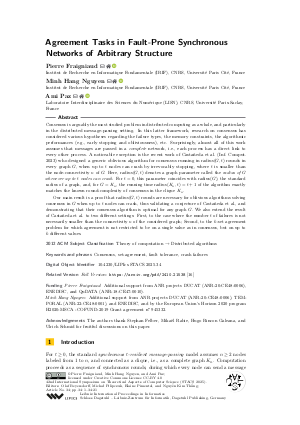LIPIcs.STACS.2025.34.pdf
- Filesize: 0.85 MB
- 21 pages

 Creative Commons Attribution 4.0 International license
Creative Commons Attribution 4.0 International license

Consensus is arguably the most studied problem in distributed computing as a whole, and particularly in the distributed message-passing setting. In this latter framework, research on consensus has considered various hypotheses regarding the failure types, the memory constraints, the algorithmic performances (e.g., early stopping and obliviousness), etc. Surprisingly, almost all of this work assumes that messages are passed in a complete network, i.e., each process has a direct link to every other process. A noticeable exception is the recent work of Castañeda et al. (Inf. Comput. 2023) who designed a generic oblivious algorithm for consensus running in radius(G,t) rounds in every graph G, when up to t nodes can crash by irrevocably stopping, where t is smaller than the node-connectivity κ of G. Here, radius(G,t) denotes a graph parameter called the radius of G whenever up to t nodes can crash. For t = 0, this parameter coincides with radius(G), the standard radius of a graph, and, for G = K_n, the running time radius(K_n,t) = t+1 of the algorithm exactly matches the known round-complexity of consensus in the clique K_n. Our main result is a proof that radius(G,t) rounds are necessary for oblivious algorithms solving consensus in G when up to t nodes can crash, thus validating a conjecture of Castañeda et al., and demonstrating that their consensus algorithm is optimal for any graph G. We also extend the result of Castañeda et al. to two different settings: First, to the case where the number t of failures is not necessarily smaller than the connectivity κ of the considered graph; Second, to the k-set agreement problem for which agreement is not restricted to be on a single value as in consensus, but on up to k different values.








Feedback for Dagstuhl Publishing